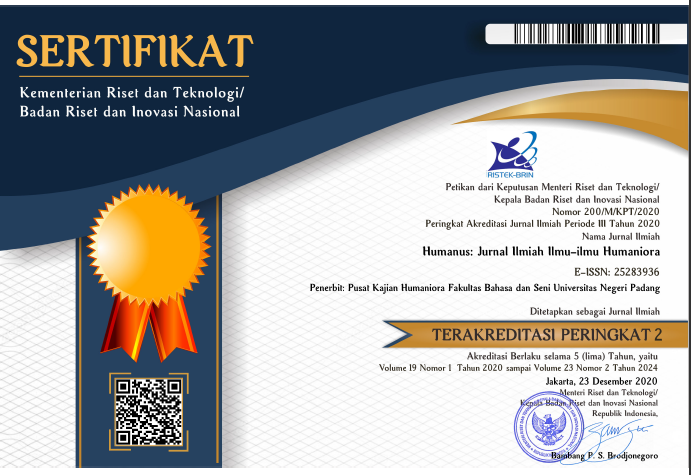Ecological Metaphor in Shinkai Makoto’s Animated Film Tenki No Ko
 ), Kemal Yusuf Indrabhaswara(2), Anton Sutandio(3),
), Kemal Yusuf Indrabhaswara(2), Anton Sutandio(3), (1) Universitas Kristen Maranatha
(2) -
(3) Universitas Kristen Maranatha
 Corresponding Author
Corresponding Author
Copyright (c) 2023 Humanus
DOI : https://doi.org/10.24036/humanus.v22i1.117183
Full Text:
 Language : en
Language : en
Abstract
Keywords
References
Arcadio, R. (2020). “Your Name” Director Makoto Shinkai Teases New Movie. The Jakarta Post. https://www.thejakartapost.com/life/2020/05/20/your-name-director-makoto-shinkai-teases-new-movie.html
Bolton, C. (2018). Interpreting Anime. University of Minnesota Press.
de Regt, H. W., & Baumberger, C. (2020). What Is Scientific Understanding and How Can It Be Achieved? In What is Scientific Knowledge: An Introduction to Contemporary Epistemology of Science (pp. 66–82). Routledge.
Forceville, C. (2009). Non-verbal and Multimodal Metaphor in a Cognitivist Framework: Agendas for Research. In C. Forceville & E. Urios-Aparisi (Eds.), Multimodal Metaphor (pp. 19–42). Mouton de Gruyter.
Furuhata, Y. (2022). Weathering with You : Mythical Time and the Paradox of the Anthropocene. Representations, 157(1), 68–89. https://doi.org/10.1525/rep.2022.157.4.68
Jones, C. (2020). Apocalyptic Ecology in The Graphic Novel: Life and The Environment After Societal Collapse. McFarland & Company, Inc.
Makoto Shinkai’s “Tenki No Ko” Anime Grosses $15 Million in 3 days. (2019). Kyodo News. https://english.kyodonews.net/news/2019/07/40611ae05cae-shinkais-tenki-no-ko-anime-grosses-15-million-in-3-days.html
McCain, K. (2020). How Do Explanations Lead to Scientific Knowledge? In What is Scientific Knowledge: An Introduction to Contemporary Epistemology of Science (pp. 52–65). Routledge.
Mulyadi, B. (2022). The Environmental Problem in Anime Weathering With You Directed By Makoto Shinkai. The7th International Conference on Energy, Environment, Epidemiology and Information System, 359, 03028. https://doi.org/10.1051/e3sconf/202235903028
Mumcu, S., & Yılmaz, S. (2018). Anime Landscapes as a Tool for Analyzing the Human–Environment Relationship: Hayao Miyazaki Films. Arts, 7(2), 1–16. https://doi.org/10.3390/arts7020016
Read, R. (2019). A-Film Philosophy of Ecology and Enlightenment. Routledge.
Riandi, A. P. (2021). Makoto Shinkai Butuh Waktu Lebih untuk Film Barunya. Kompas.Com. https://www.kompas.com/hype/read/2021/01/04/141419966/makoto-shinkai-butuh-waktu-lebih-untuk-film-barunya
Rohdin, M. (2009). Multimodal Metaphor in Classical Film Theory from the 1920s to the 1950s. In C. Forceville & E. Urios-Aparisi (Eds.), Multimodal Metaphor (pp. 403–428). Mouton de Gruyter.
Shinkai, M. (2019). Tenki no Ko. Toho Co., Ltd.
Sosa, E. (2017). Epistemology. Princeton University Press.
Sutanto, M. R., Sobarna, C., Risagarniwa, Y. Y., & Saleha, A. (2020). Redescription of Maiko and Geiko Identities: Metaphorical Reading in Suo Masayuki’s Maiko wa Lady. PalArch’s Journal of Archaeology of Egypt / Egyptology, 17(6), 84–101. https://archives.palarch.nl/index.php/jae/article/view/708%0A
Sutanto, M. R., Sobarna, C., Risagarniwa, Y. Y., & Saleha, A. (2021). Representation of Consumptive Society on Monk Lifestyle in “Fancy Dance.” Psychology and Education, 58(2), 6130–6138. http://psychologyandeducation.net/pae/index.php/pae/article/view/3129
Thelen, T. (2016). Disaster and Salvation in the Japanese Periphery. “The Rural” in Shinkai Makoto’s Kimi no na wa (Your Name). Ffk Journal, 4, 215–230. https://doi.org/https://doi.org/10.25969/mediarep/3697
Ureña Gómez-Moreno, J. M. (2017). Online Construction of Multimodal Metaphors in Murnau’s Movie Faust (1926). Metaphor and Symbol, 32(3), 192–210. https://doi.org/10.1080/10926488.2017.1338024
Wulandari, Y. (2017). Kearifan Ekologis dalam Legenda “Bujang Sembilan” (Asal Usul Danau Maninjau). Madah, 8(1), 105–114. https://doi.org/http://dx.doi.org/10.26499/madah.v8i1.376
Yoneyama, S. (2020). Rethinking Human-Nature Relationships in The Time of Coronavirus: Postmodern Animism in Films by Miyazaki Hayao & Shinkai Makoto. Asia-Pasific Journal: Japan Focus, 18(16), 1–16.
 Article Metrics
Article Metrics
 Abstract Views : 658 times
Abstract Views : 658 times
 PDF Downloaded : 332 times
PDF Downloaded : 332 times
Refbacks
- There are currently no refbacks.
Copyright (c) 2023 Humanus

This work is licensed under a Creative Commons Attribution-NonCommercial 4.0 International License.










